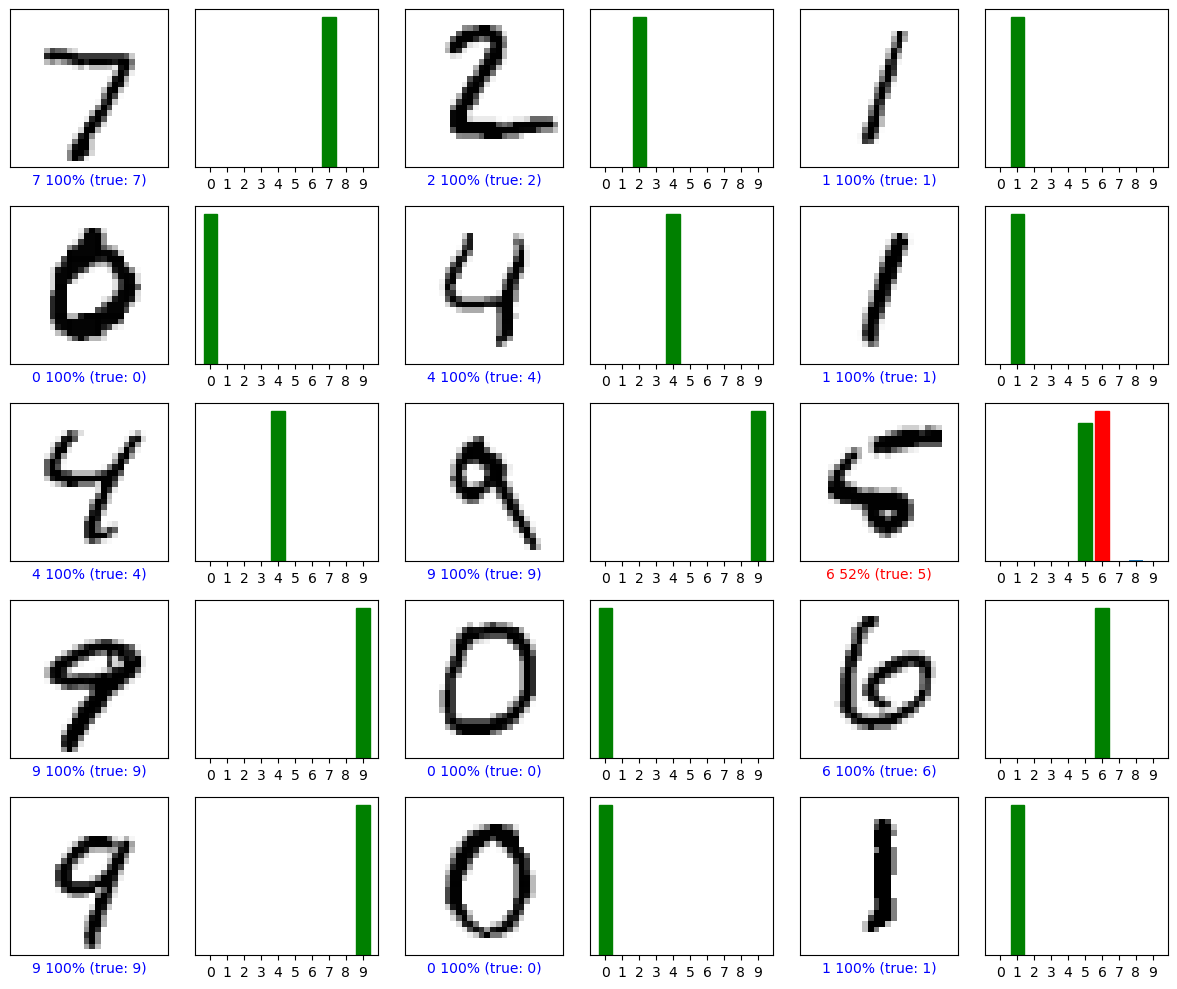24.5. MNIST classifier in PyTorch#
This notebook is a PyTorch rewrite of the original TensorFlow/Keras demo.
It trains a simple fully-connected network on MNIST and reproduces:
data loading
model definition (Flatten → Dense(128, ReLU) → Dropout(0.2) → Dense(10))
training for 10 epochs
accuracy on the test set
probability predictions for a sample
the same plotting helpers for predictions
# Imports
import os, math, numpy as np
import torch
from torch import nn
from torch.utils.data import DataLoader
from torchvision import datasets, transforms
import matplotlib.pyplot as plt
print('You have PyTorch version:', torch.__version__)
device = torch.device('cuda' if torch.cuda.is_available() else 'cpu')
print('Using device:', device)
torch.manual_seed(1234)
You have PyTorch version: 2.8.0
Using device: cpu
<torch._C.Generator at 0x7f7524f3bf90>
# Data: MNIST via torchvision (returns tensors in [0,1])
batch_size = 128
transform = transforms.ToTensor() # simple scaling to [0,1]
train_dataset = datasets.MNIST(root='./data', train=True, download=True, transform=transform)
test_dataset = datasets.MNIST(root='./data', train=False, download=True, transform=transform)
x_train = train_dataset.data.numpy()
y_train = train_dataset.targets.numpy()
x_test = test_dataset.data.numpy()
y_test = test_dataset.targets.numpy()
train_loader = DataLoader(train_dataset, batch_size=batch_size, shuffle=True, num_workers=2)
test_loader = DataLoader(test_dataset, batch_size=batch_size, shuffle=False, num_workers=2)
print('Train:', len(train_dataset), 'Test:', len(test_dataset))
Train: 60000 Test: 10000
# Model: Flatten → Linear(784,128) → ReLU → Dropout(0.2) → Linear(128,10)
class MLP(nn.Module):
def __init__(self):
super().__init__()
self.net = nn.Sequential(
nn.Flatten(),
nn.Linear(28*28, 128),
nn.ReLU(),
nn.Dropout(0.2),
nn.Linear(128, 10)
)
def forward(self, x):
return self.net(x)
model = MLP().to(device)
sum(p.numel() for p in model.parameters()), model
(101770,
MLP(
(net): Sequential(
(0): Flatten(start_dim=1, end_dim=-1)
(1): Linear(in_features=784, out_features=128, bias=True)
(2): ReLU()
(3): Dropout(p=0.2, inplace=False)
(4): Linear(in_features=128, out_features=10, bias=True)
)
))
# Training
criterion = nn.CrossEntropyLoss() # expects raw logits
optimizer = torch.optim.Adam(model.parameters())
epochs = 10
history = {'accuracy': [], 'loss': []}
for epoch in range(1, epochs+1):
model.train()
running_loss = 0.0
correct, total = 0, 0
for xb, yb in train_loader:
xb, yb = xb.to(device), yb.to(device)
optimizer.zero_grad()
logits = model(xb)
loss = criterion(logits, yb)
loss.backward()
optimizer.step()
running_loss += loss.item() * xb.size(0)
# compute training accuracy
preds = logits.argmax(dim=1)
correct += (preds == yb).sum().item()
total += yb.size(0)
epoch_loss = running_loss / total
epoch_acc = correct / total
history['loss'].append(epoch_loss)
history['accuracy'].append(epoch_acc)
print(f'Epoch {epoch:2d}/{epochs} - loss: {epoch_loss:.4f} - acc: {epoch_acc:.4f}')
history
Epoch 1/10 - loss: 0.4464 - acc: 0.8796
Epoch 2/10 - loss: 0.2149 - acc: 0.9373
Epoch 3/10 - loss: 0.1596 - acc: 0.9535
Epoch 4/10 - loss: 0.1290 - acc: 0.9617
Epoch 5/10 - loss: 0.1077 - acc: 0.9687
Epoch 6/10 - loss: 0.0928 - acc: 0.9725
Epoch 7/10 - loss: 0.0822 - acc: 0.9751
Epoch 8/10 - loss: 0.0748 - acc: 0.9772
Epoch 9/10 - loss: 0.0672 - acc: 0.9794
Epoch 10/10 - loss: 0.0591 - acc: 0.9823
{'accuracy': [0.8795666666666667,
0.9372833333333334,
0.95345,
0.9617,
0.9687166666666667,
0.9725,
0.97515,
0.9772333333333333,
0.9794,
0.9823],
'loss': [0.4463983178456624,
0.21493444612026213,
0.1596157058954239,
0.1290262913386027,
0.10767514850695928,
0.09282231144507726,
0.08220300891399383,
0.07477020881772041,
0.06717816098332405,
0.05907997849583626]}
# Evaluation on test set
model.eval()
correct, total, test_loss = 0, 0, 0.0
with torch.no_grad():
for xb, yb in test_loader:
xb, yb = xb.to(device), yb.to(device)
logits = model(xb)
loss = criterion(logits, yb)
test_loss += loss.item() * xb.size(0)
preds = logits.argmax(dim=1)
correct += (preds == yb).sum().item()
total += yb.size(0)
test_acc = correct / total
test_loss = test_loss / total
print(f'\nTest accuracy: {test_acc:5.3f}')
test_acc
Test accuracy: 0.978
0.9775
# Predict class probabilities for the first test image (to mirror Keras softmax output)
softmax = nn.Softmax(dim=1)
model.eval()
with torch.no_grad():
sample = test_dataset[0][0].unsqueeze(0).to(device) # 1x1x28x28
probs = softmax(model(sample)).cpu().numpy()[0]
probs, probs.sum(), probs.argmax()
(array([3.6496281e-06, 6.8333939e-08, 1.1807497e-05, 5.3805462e-04,
5.3760618e-10, 1.7252582e-06, 1.9389098e-13, 9.9938619e-01,
2.5817704e-07, 5.8283444e-05], dtype=float32),
1.0,
7)
# Helper plotting functions (ported from the Keras version)
def plot_image(i, predictions_array, true_label, img):
predictions_array, true_label, img = predictions_array, int(true_label), img
plt.grid(False)
plt.xticks([])
plt.yticks([])
plt.imshow(img, cmap=plt.cm.binary)
predicted_label = int(np.argmax(predictions_array))
color = 'blue' if predicted_label == true_label else 'red'
plt.xlabel(f"{predicted_label} {100*np.max(predictions_array):2.0f}% (true: {true_label})", color=color)
def plot_value_array(i, predictions_array, true_label):
predictions_array, true_label = predictions_array, int(true_label)
plt.grid(False)
plt.xticks(range(10))
plt.yticks([])
thisplot = plt.bar(range(10), predictions_array)
predicted_label = int(np.argmax(predictions_array))
thisplot[predicted_label].set_color('red')
thisplot[true_label].set_color('green')
# Plot a grid of test images with predicted probabilities
num_rows = 5
num_cols = 3
num_images = num_rows * num_cols
plt.figure(figsize=(2*2*num_cols, 2*num_rows))
# Precompute probabilities for first num_images
with torch.no_grad():
xs = torch.stack([test_dataset[i][0] for i in range(num_images)]).to(device)
probs_batch = nn.Softmax(dim=1)(model(xs)).cpu().numpy()
for i in range(num_images):
img, label = test_dataset[i]
plt.subplot(num_rows, 2*num_cols, 2*i+1)
plot_image(i, probs_batch[i], label, img.squeeze().numpy())
plt.subplot(num_rows, 2*num_cols, 2*i+2)
plot_value_array(i, probs_batch[i], label)
plt.tight_layout()
plt.show()


